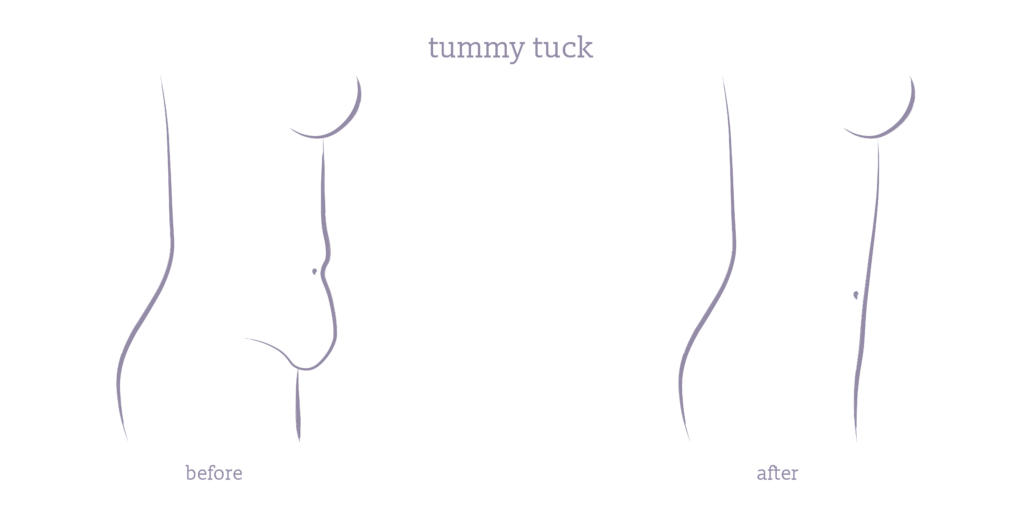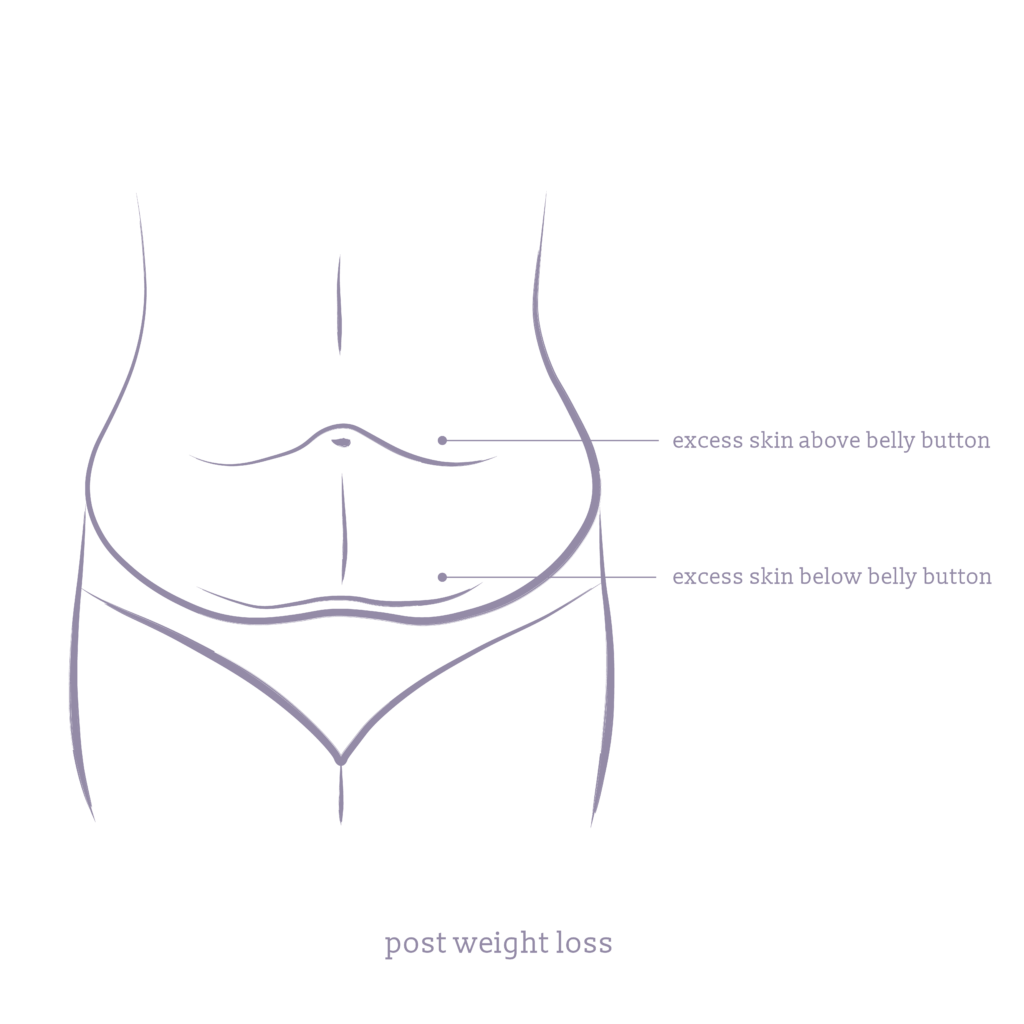Many people think that a tummy tuck is a way to lose weight. However, this is a common misunderstanding. A tummy tuck, known as abdominoplasty surgery, isn’t about losing weight. A tummy tuck after weight loss can shape and refine your body in ways that diets and exercise can’t achieve alone.
After losing a lot of weight, especially from surgeries or big lifestyle changes, many find that they still don’t have the body shape they want because of excess skin. This is where a tummy tuck comes in. It removes this extra skin and addresses abdominal muscle separation, providing the finishing touches to your weight loss efforts.
This blog will explore how a tummy tuck can complement your hard work and help you fully achieve your body transformation goals.
The limitations of weight loss alone
While achieving significant weight loss is a remarkable health milestone, the journey doesn’t always end with just reaching a target weight. Many individuals find that certain physical results remain unattainable despite their best efforts in dieting and exercising. This can be disheartening, especially when loose, sagging skin clouds the achievements of their hard work.
The natural ability of our bodies to reshape and tighten skin post-significant weight loss has limits, which often necessitates considering surgical options to achieve the desired body contour. This is why surgical intervention, such as a tummy tuck, is sometimes essential to meet those final body-shaping goals through body contouring surgery.

➔ understanding skin elasticity and body contour limits
Weight loss, particularly significant ones, often leads to an undesirable outcome: loose skin that no diet or exercise regimen can tighten.
As individuals lose weight, their stretched skin may not have enough elasticity to shrink back to the reduced body size. This is especially true for those who lose a large amount of weight quickly or are older, as skin elasticity tends to diminish with age.
The body’s limited ability to naturally tighten this excess skin can lead to both functional and aesthetic appearance issues, making it challenging to fully appreciate the results of significant weight loss.
Surgical intervention, such as a tummy tuck, becomes a valuable solution for removing this loose skin and effectively reshaping body contours through plastic surgery.
➔ fat loss does not mean skin removal
A common misconception is that continued weight loss will eventually tighten sagging skin. This belief leads many to pursue further dieting or intense exercise, only to find that the excess skin remains.
It’s important to understand that losing fat and removing skin are two distinctly different processes. While fat loss results from burning more calories than consumed, decreasing body fat percentage does not directly affect the skin’s capacity to retract.
Massive weight loss typically results in leftover skin, so surgical procedures like tummy tucks are often necessary. These procedures not only remove excess skin but also tighten the abdominal area, providing the desired aesthetic results that are not achievable through weight loss alone.
Understanding tummy tuck surgery

➔ definition of tummy tuck surgery
A tummy tuck, also known as abdominoplasty surgery, is a type of cosmetic surgery designed to remove excess skin and fat from the abdominal area while tightening the underlying muscles.
This procedure is particularly beneficial for individuals who have experienced significant weight loss or pregnancy, which often leaves behind loose, sagging skin that cannot be addressed through diet and exercise alone.
Generally, during a full tummy tuck surgery, a plastic surgeon makes an incision along the lower abdomen, removes the excess skin, and tightens the abdominal muscles to create a firmer, flatter stomach.
➔ benefits of tummy tuck surgery
The benefits of tummy tuck surgery extend beyond mere aesthetics. Firstly, it significantly improves body contour by removing excess skin and tightening the abdominal area, resulting in a smoother and more toned appearance. This can greatly enhance self-confidence and body image.
A tummy tuck can also alleviate physical discomfort caused by sagging skin, such as skin irritation, chafing, and infections. For many, the procedure also strengthens the abdominal muscles, which can improve posture and reduce back pain.
Stretch marks can be removed with abdominoplasty, as any stretch marks in the treated area will be removed alongside the excess skin.
Overall, a tummy tuck offers both cosmetic and functional benefits, making it a valuable option for those looking to complete their body transformation journey.
If you want to see the changes and benefits our patients have experienced after abdominoplasty tummy tuck, check out the me clinic tummy tuck before and after photos.
Why a tummy tuck after weight loss is ideal
Losing weight is a significant achievement, but as we have discussed, it sometimes leaves behind excess skin, causing dissatisfaction. A tummy tuck addresses this by removing the excess skin and enhancing the body’s appearance. This procedure is ideal after weight loss, and the reason is below.

➔ it complements weight loss
A tummy tuck complements weight loss by addressing what diet and exercise cannot—excess skin removal. After significant weight reduction, the skin may fail to retract entirely, leaving saggy or loose areas that detract from the overall results. By removing this excess skin and tightening the underlying abdominal muscles, a tummy tuck enhances the body’s new shape, providing a firmer, flatter abdomen and a more defined waistline.
Tummy tuck surgery has a complementary relationship with weight loss and bariatric surgery, allowing patients to gain all the benefits of weight loss without worrying about sagging skin limitations. Patients considering these procedures should check with their private health insurance providers to understand their coverage and potential out of pocket costs. During your consultation and contact with me clinic, we will provide guidance on Medicare coverage on abdominoplasty surgery, and with your private health insurer and cost-breakdowns.
Understanding the costs involved is crucial. Visit our tummy tuck costs page for an overview of what to expect and costs involved with your procedure.
Bariatric surgery, a type of procedure that helps people lose significant amounts of weight by altering the digestive system, is often paired with abdominoplasty, or a tummy tuck, to address the aftermath of rapid weight loss. This combination is common because while bariatric surgery effectively reduces body weight, there is no excess skin removal. Instead, bariatric surgery frequently leaves behind excess skin that only a tummy tuck can remove. Together, these procedures help achieve a more natural and aesthetically pleasing body contour.
➔ offers body contouring results naturally unattainable
While weight loss can significantly reduce body fat, it does not necessarily offer the aesthetic body contouring many desire. A tummy tuck goes beyond mere weight loss to sculpt the body in a way natural methods cannot. This surgical procedure finely tunes the abdominal area, creating smoother contours and a more proportionate figure that reflects an individual’s actual weight loss success.
For many, this is the key to feeling fully satisfied with their transformation, as it delivers a visual and tangible realisation of their hard work.
➔ sometimes it’s a skin issue, not a weight issue
Many individuals who are unhappy with their post-weight loss body shape believe that losing more weight is the solution. However, the real issue often lies with the excess skin that creates an illusion of unshed weight. This misperception can lead to unnecessary and unhealthy attempts to lose more weight, which might be futile and detrimental to health.
A tummy tuck directly addresses this issue by removing the excess skin, revealing the true extent of an individual’s weight loss. For many, understanding that their dissatisfaction is due to skin and not additional body fat can be a revelation, guiding them towards a tummy tuck as a more effective solution than continued dieting or exercise.
Recognising the need for a tummy tuck after weight loss
After massive weight loss, deciding on further steps to enhance body contour can be challenging. A tummy tuck, or abdominoplasty, is often the solution for many who struggle with excess skin that diet and exercise can’t fix. Understanding when to consider this procedure can help you make an informed decision.

➔ signs you might need a tummy tuck after weight loss
If you’re wondering whether a tummy tuck is right for you, here are some signs that it might be beneficial:
- Excess skin that hangs
This is common in the abdominal area and can sometimes extend around the sides and lower back. - Skin irritation and chafing
Excess skin can lead to discomfort and even skin infections in severe cases. - Poor body contour despite significant weight loss
If you’ve reached or are near your target weight but are unhappy with the amount of loose skin affecting your body shape. - Abdominal muscle laxity
For many, especially post-pregnancy women, the abdominal muscles may be stretched by injury, excess weight or age and can benefit from tightening during the procedure. This is less common for post-weight loss patients.
For more detailed insights into the abdominoplasty procedure and what to expect, check our comprehensive guide on tummy tuck surgery.
➔ consulting a plastic surgeon
When considering a tummy tuck, it’s crucial to consult with a specialist plastic surgeon. At the me clinic, our team of experienced specialist plastic surgeons can provide you with a detailed assessment and discuss how a tummy tuck can address your specific concerns.
During the consultation, be prepared to discuss your weight loss journey, your current health status, and your expectations for the surgery. This conversation will help determine if a tummy tuck is your best option and what results you can expect.
What tummy tuck method for post-weight loss patients?
All tummy tuck procedures share the same fundamental goal to create a smoother, firmer abdominal profile. However, the specific method employed can vary significantly depending on the patient’s needs and the extent of correction required.
There are different types of tummy tucks, each designed to target specific areas of excess skin and fat. Plastic surgeons evaluate each patient’s unique body shape and weight loss journey to determine the most effective approach for achieving the best results.
➔ where loose skin is after weight loss
Excess skin can be prevalent around and above the belly button for patients who have experienced significant weight loss, often requiring more comprehensive surgical intervention. This scenario is notably different from post-pregnancy tummy tucks, where the focus might primarily be below the belly button due to pregnancy-related skin stretching and muscle separation.
Post-weight loss patients typically require a full abdominoplasty or variations like a fleur de lis or high-tension abdominoplasty, as the loose skin often extends over a larger area. This method ensures that the skin above the belly button is also tightened effectively, providing a uniform contour and aesthetic that aligns with the patient’s overall body transformation goals.
Plastic surgeons tailor the procedure to remove the excess skin in both upper and lower abdominal regions, ensuring a balanced and aesthetically pleasing result.
➔ addressing separated abdominal muscles
Muscle laxity in the abdominal area, often discussed in the context of post-pregnancy, can also be a significant issue for individuals who have experienced major weight loss. This condition, known as diastasis recti, involves the weakening and separation of the abdominal muscles. Although more commonly associated with pregnancy due to the intense strain placed on the abdomen, substantial weight fluctuations can similarly affect these muscles. Learn more about the differences between diastasis recti and abdominal fat in this guide.

In cases of extreme weight loss, particularly where individuals lose a large amount of weight quickly, the risk of muscle laxity increases as the muscles may have been stretched beyond their capacity to retract naturally.
During a tummy tuck, surgeons address this by performing muscle repair, which involves suturing the stretched or separated muscles back together. This crucial step enhances the abdominal contour and strengthens structural support.
This improvement can alleviate back pain and improve posture, significantly enhancing the patient’s overall quality of life.
➔ the importance of a tummy tuck after weight loss consultation
This is why a consultation for your tummy tuck, especially after massive weight loss, is so important. Your surgeon will thoroughly assess your specific case and needs, which may differ from your initial expectations and help you understand what is required for your tummy tuck.
This personalised assessment ensures that the chosen method addresses your unique concerns and achieves the best possible results. It is explicitly tailored to enhance and complement your weight loss achievements.
Get in contact with me clinic today to book a consultation and assessment via our contact form.
Or alternatively you can get contact me clinic the following ways:
- Phone me clinic at 03 9569 3511
- Get an online consultation assessment
Further reading about tummy tuck
- Visit the Me Clinic Abdominoplasty / Tummy Tuck surgery page
- Visit the Tummy Tuck surgery cost page
- Visit the Tummy Tuck surgery before and after photo gallery
- Visit the Ideal Weight for a Tummy Tuck blog.
Medical references about tummy tuck after weight loss
- Bracaglia, R., D’Ettorre, M., Gentileschi, S., & Tambasco, D. (2012). “Vest over pants” abdominoplasty in post-bariatric patients. Aesthetic plastic surgery, 36(1), 23–27.
{Visit} - Lo Torto, F., Marcasciano, M., Frattaroli, J. M., Kaciulyte, J., Mori, F. L. R., Redi, U., Casella, D., Cigna, E., & Ribuffo, D. (2020). Quality Assessment of Online Information on Body Contouring Surgery in Postbariatric Patient. Aesthetic plastic surgery, 44(3), 839–846.
{Visit}
FAQs about tummy tuck after weight loss
- What is a tummy tuck?
A tummy tuck, or abdominoplasty, is a surgical procedure that removes excess skin and fat from the abdomen and tightens the abdominal muscles. - How long is the recovery after a tummy tuck?
Recovery time varies, but most patients can return to normal activities within 2-4 weeks, with full recovery taking up to six months. For Recovery After Abdominoplasty: Key Steps for Effective Healing, check out our tips on surgery recovery. - Can a tummy tuck help me if I’ve lost a lot of weight?
Yes, a tummy tuck is ideal for removing excess skin and tightening the abdomen after significant weight loss. - Is a tummy tuck necessary after bariatric surgery?
While not always necessary, many patients opt for a tummy tuck after bariatric surgery to remove excess skin and improve body contours. - How does a tummy tuck complement weight loss?
A tummy tuck complements weight loss by tightening loose skin and abdominal muscles, which enhances the body’s overall shape and contour. - What should I expect during a consultation for a tummy tuck after weight loss?
During a consultation, your plastic surgeon will assess your skin elasticity, abdominal muscle condition, and overall health to determine the best surgical approach for you. - How long should I wait after losing weight to have a tummy tuck?
It’s best to wait until your weight has stabilised for at least 6-12 months to ensure lasting results and minimise complications. - Who is a good candidate for a tummy tuck procedure?
Ideal candidates for tummy tuck surgery are those who have excess skin and fat in the abdominal area following significant weight loss or multiple pregnancies (with no intention of future pregnancies) and have not seen improvement from diet and exercise alone. - What are the common risks and complications of tummy tuck surgery
Like any major surgery, a tummy tuck comes with its own set of risks and potential complications.
Common risks include infection, which can occur if the surgical site is not adequately cared for, and scarring, which is an inevitable part of the healing process but can be minimised with proper post-operative care.
Blood clots, such as deep vein thrombosis, are another serious risk, particularly if the patient is immobile for extended periods after surgery. Other potential complications include poor wound healing, fluid accumulation, and changes in skin sensation.
Discuss these risks with your plastic surgeon and follow all pre-and post-operative instructions, such as wearing a compression garment, to minimise complications and ensure a smooth recovery.


